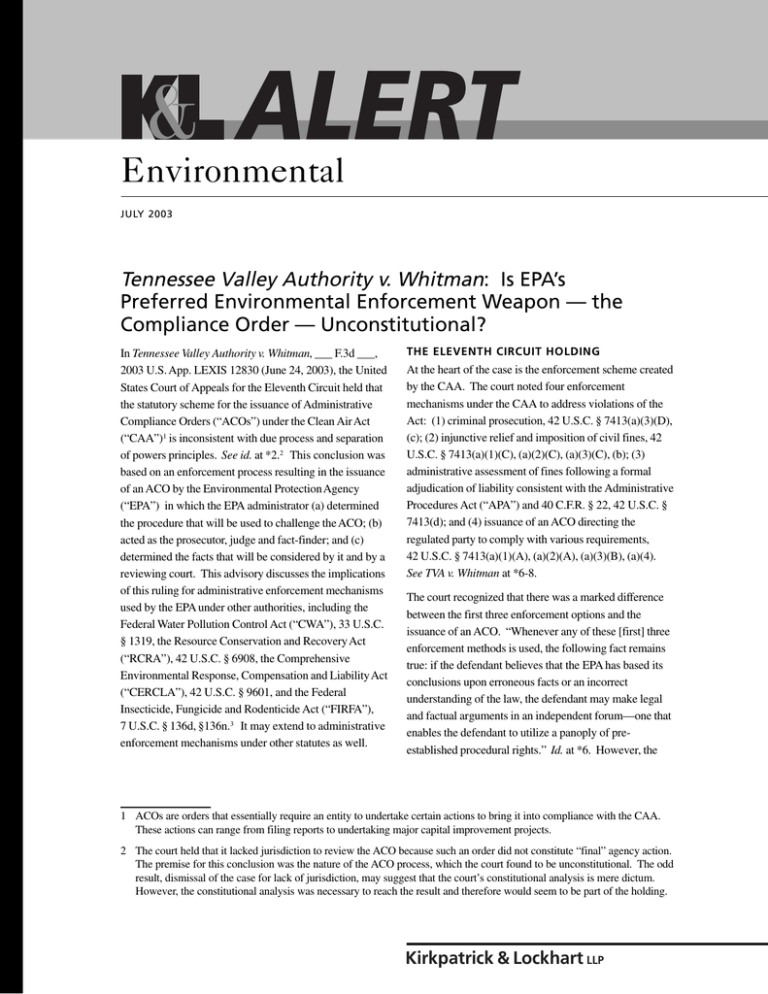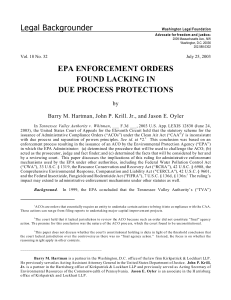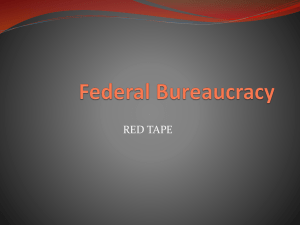
Environmental
JULY 2003
Tennessee Valley Authority v. Whitman: Is EPA’s
Preferred Environmental Enforcement Weapon — the
Compliance Order — Unconstitutional?
In Tennessee Valley Authority v. Whitman, ___ F.3d ___,
2003 U.S. App. LEXIS 12830 (June 24, 2003), the United
States Court of Appeals for the Eleventh Circuit held that
the statutory scheme for the issuance of Administrative
Compliance Orders (“ACOs”) under the Clean Air Act
(“CAA”)1 is inconsistent with due process and separation
of powers principles. See id. at *2.2 This conclusion was
based on an enforcement process resulting in the issuance
of an ACO by the Environmental Protection Agency
(“EPA”) in which the EPA administrator (a) determined
the procedure that will be used to challenge the ACO; (b)
acted as the prosecutor, judge and fact-finder; and (c)
determined the facts that will be considered by it and by a
reviewing court. This advisory discusses the implications
of this ruling for administrative enforcement mechanisms
used by the EPA under other authorities, including the
Federal Water Pollution Control Act (“CWA”), 33 U.S.C.
§ 1319, the Resource Conservation and Recovery Act
(“RCRA”), 42 U.S.C. § 6908, the Comprehensive
Environmental Response, Compensation and Liability Act
(“CERCLA”), 42 U.S.C. § 9601, and the Federal
Insecticide, Fungicide and Rodenticide Act (“FIRFA”),
7 U.S.C. § 136d, §136n.3 It may extend to administrative
enforcement mechanisms under other statutes as well.
THE ELEVENTH CIRCUIT HOLDING
At the heart of the case is the enforcement scheme created
by the CAA. The court noted four enforcement
mechanisms under the CAA to address violations of the
Act: (1) criminal prosecution, 42 U.S.C. § 7413(a)(3)(D),
(c); (2) injunctive relief and imposition of civil fines, 42
U.S.C. § 7413(a)(1)(C), (a)(2)(C), (a)(3)(C), (b); (3)
administrative assessment of fines following a formal
adjudication of liability consistent with the Administrative
Procedures Act (“APA”) and 40 C.F.R. § 22, 42 U.S.C. §
7413(d); and (4) issuance of an ACO directing the
regulated party to comply with various requirements,
42 U.S.C. § 7413(a)(1)(A), (a)(2)(A), (a)(3)(B), (a)(4).
See TVA v. Whitman at *6-8.
The court recognized that there was a marked difference
between the first three enforcement options and the
issuance of an ACO. “Whenever any of these [first] three
enforcement methods is used, the following fact remains
true: if the defendant believes that the EPA has based its
conclusions upon erroneous facts or an incorrect
understanding of the law, the defendant may make legal
and factual arguments in an independent forum—one that
enables the defendant to utilize a panoply of preestablished procedural rights.” Id. at *6. However, the
1 ACOs are orders that essentially require an entity to undertake certain actions to bring it into compliance with the CAA.
These actions can range from filing reports to undertaking major capital improvement projects.
2 The court held that it lacked jurisdiction to review the ACO because such an order did not constitute “final” agency action.
The premise for this conclusion was the nature of the ACO process, which the court found to be unconstitutional. The odd
result, dismissal of the case for lack of jurisdiction, may suggest that the court’s constitutional analysis is mere dictum.
However, the constitutional analysis was necessary to reach the result and therefore would seem to be part of the holding.
Kirkpatrick & Lockhart LLP
court explained that ACOs are issued with the “status of
law,” but are meant to be issued and usually are issued by
the EPA without an adjudication. See id. at *8-10.
Further, section 7413 makes a violation of the terms of an
ACO itself a “basis for the imposition of extensive civil
fines or imprisonment.” Id. at *10. See also 42 U.S.C. §
7413(b) (the Administrator may commence a civil action
when a “person has violated … any … order … issued, or
approved under this chapter”); 42 U.S.C. § 7413(c)(1)
(“[a]ny person who knowingly violates … any order under
subsection (a) of this section … shall upon conviction, be
punished by a fine pursuant to Title 18, or by
imprisonment not to exceed 5 years, or both”).
Additionally, because the Administrator may issue an
ACO on the basis of “any information available,” an ACO
may be based on a newspaper article or an anonymous tip,
without any opportunity for the regulated party to
meaningfully argue the law and facts before a neutral
tribunal. This situation is compounded by the fact that the
ACO can be an independent basis for imposition of civil
and criminal liabilities. As a result, the court reasoned that
this enforcement scheme for ACOs establishes a system
where the “EPA is the ultimate arbiter of guilt or
innocence, and the courts are relegated to a forum that
conducts a proceeding, akin to a show-cause hearing, on
the issue of whether an EPA order has been flouted.” TVA
v. Whitman at *15. The court ultimately held that “this
scheme violates the Due Process Clause and the
separation-of-powers principle.” Id.
DUE PROCESS AND SEPARATION OF POWERS
While other courts have addressed whether there is preenforcement review of an ACO, the panel concluded that
“[n]o court has discussed the constitutional issues inherent
in a scheme in which an executive branch agency can (a)
make a finding, on the basis of ‘any information available,’
that the law has been violated and (b) issue a compliance
order which, if ignored, leads automatically to the
imposition of severe civil penalties and perhaps
imprisonment.” Id. at *55. The court found this
enforcement scheme to be “repugnant to the Due Process
Clause of the Fifth Amendment.” Id. at *62.
The court declared, “Before the Government can impose
severe civil and criminal penalties, the defendant is entitled
to a full and fair hearing before an impartial tribunal ‘at a
meaningful time and in a meaningful manner.’” Id. (quoting
Armstrong v. Manzo, 380 U.S. 545, 552 (1965)). The court
held that the “scheme enacted by Congress deprives the
regulated party of ‘a reasonable opportunity to be heard and
present evidence’ on the two most crucial issues: (a) whether
the conduct underlying the issuance of the ACO actually
took place and (b) whether the alleged conduct amounts to a
CAA violation.” Id. (quoting Yakus v. United States, 321
U.S. 414, 433 (1944)).4
The court further reasoned that the EPA Administrator
cannot “amend the statute” by creating a hearing process
before it issues an ACO in which it is the prosecutor, judge
and fact-finder.3 See id. at *63. “Far from rendering the
statutory scheme more palatable, a pre-ACO adjudication
would only highlight another constitutional problem with
the CAA: the statutory scheme unconstitutionally delegates
judicial power to a non-Article III tribunal.” Id. at *63-64
(citing N. Pipeline Construction Co. v. Marathon Pipeline
Co., 458 U.S. 50 (1982)). “The statutory scheme relegates
Article III courts to insignificant tribunals. The district
courts serve as forums for the EPA to conduct show-cause
hearings. And the courts of appeal are similarly
emasculated, reviewing only whether the ACO has been
validly issued—i.e., whether the Administrator’s decision to
issue the ACO was based upon ‘any information’ as opposed
to no information at all.” Id. at *64. The court explained,
“Without meaningful judicial review, the scheme works an
unconstitutional delegation of judicial power.” Id.
The court concluded:
The Clean Air Act is unconstitutional to the extent
that mere noncompliance with the terms of an ACO
can be the sole basis for the imposition of severe civil
and criminal penalties. Therefore, ACOs lack finality
because they do not meet prong two of the Bennett
test. We thus conclude that courts of appeals lack
jurisdiction to review the validity of ACOs. The EPA
must do what it believes it has been required to do all
along—namely, prove the existence of a CAA
3 Because of TVA’s status as a government agency of sorts, EPA took the unusual step of allowing its ACO to be reviewed by
its Environmental Appeals Board. Although private parties that receive ACOs will not be afforded such process, the court’s
constitutional analysis does not turn on the unique process used in this case.
2
4 In a specially concurring opinion joined by Judge Wilson, Judge Barkett noted that even though the Administrator
attempted to fill the gap in the statute and provide process to TVA, such an attempt “cannot be deemed sufficient because
constitutional due process cannot be provided on an ad hoc basis under the direction and control of the entity whose
decision is being challenged.” Id. at *70.
KIRKPATRICK & LOCKHART LLP ENVIRONMENTAL ALERT
violation in district court, including the alleged
violation that spurred the EPA to issue the ACO in
this case.
Id. at *67.
APPLICATION TO OTHER ADMINISTRATIVE
ENFORCEMENT SCHEMES
The CWA contains an administrative compliance order
scheme strikingly similar to the one in the CAA and is
materially identical to the CAA. See 33 U.S.C. §
1319(a).5 Like the CAA, the Administrator may issue a
compliance order “on the basis of any information
available to him.” Id. Moreover, the CWA provides for
civil penalties for violations of an order, 33 U.S.C.
§1319(d), [per day for each violation.] Unlike the CAA,
the CWA may not directly provide that the failure to
comply with an order will lead to criminal penalties. See
id. at § 1319(c).6 Further, under section 309, the
Administrator has the authority to assess administrative
penalties. 33 U.S.C. § 1319(g). Although there is an
administrative review process in which the Administrator
functions as prosecutor, judge and fact-finder,7 33 U.S.C.
§ 1319(g)(4), judicial review is not de novo, 33 U.S.C. §
1319(g)(8). This process may raise the unlawful Article III
delegation issues addressed in TVA v. Whitman.8
RCRA contains a similar enforcement mechanism as well.
See 42 U.S.C. § 6928. “[W]henever on the basis of any
information the Administrator determines that any person
has violated or is in violation of any requirement of this
subchapter, the Administrator may issue an order assessing
a civil penalty for any past or current violation, requiring
compliance immediately or within a specified time frame,
or both . .. .” Id. at § 6928(a)(1). RCRA further provides
that if a recipient of an order “fails to take corrective action
within the time specified in a compliance order, the
Administrator may assess a civil penalty of not more than
$25,000 for each day of continued noncompliance....” Id.
at § 6928(c). Like the CWA, RCRA does not appear to
provide criminal penalties for violation of a compliance
order. See id. at § 6928(d). However, unlike the CAA and
CWA, RCRA does provide that any compliance order
issued by the Administrator be subject to a public hearing,
if requested within 30 days after the order is served. See
id. at § 6928(b). Upon a request for a public hearing, the
Administrator must promptly conduct the hearing and
“may issue subpoenas for the attendance and testimony of
witnesses and the production of relevant papers, books,
and documents, and may promulgate rules for discovery
procedures.” Id. The procedure for such a public hearing
is provided before the Environmental Appeals Board in
accordance with the rules established in 40 C.F.R. Part 22.
See 40 C.F.R. § 22.1(a)(4). This procedure may address
certain of the due process issues raised in TVA v. Whitman,
at *6-7 and n.8, but the RCRA scheme still presents an
issue as to whether it impermissibly commingles the
prosecutorial and adjudicative functions or implicates
separation of powers concerns, since the Administrator is
again acting as the prosecutor, judge and fact-finder, and
determines what facts will be included in the record for
purposes of limited judicial review.
Although CERCLA is distinguishable in that the unilateral
order mechanism under section 106 does not require the
existence of a violation,9 the process governing section
106 unilateral administrative orders (“UAOs”) may suffer
from constitutional defects similar to ACOs under the
CWA. CERCLA UAOs are issued unilaterally, without a
hearing or record. Most UAOs include a provision that
appears to make the recipient liable for a civil penalty of
up to $27,500 per day, as well as for treble damages, for
failing to comply with the order. While a party does have
a right to judicial review of the UAO, that review is
statutorily limited to situations where the EPA first files an
5 This similarity was noted by the court in TVA v. Whitman at *40 n.32.
6 Whether the level of civil sanctions can be so severe as to constitute a penal sanction is an open question. Cf. Hudson v.
United States, 522 U.S. 93 (1997) (analyzing whether a statutory scheme is so punitive either in purpose or effect as to
transform civil remedies into criminal penalties).
7 The same procedure applies to enforcement actions brought by the Secretary of the Army for “dredge and fill” violations
under section 404.
8 We expect the TVA court’s view of the doctrine of delegation/separation of powers to be vigorously contested by the EPA
and by other federal administrative agencies.
9 CERCLA section 106 requires the existence of “an imminent and substantial endangerment to the public health or welfare
or the environment because of an actual or threatened release of a hazardous substance from a facility . . . .” 42 U.S.C. §
9606. Generally, these orders are issued to potentially responsible parties and require that they undertake expansive and
expensive remedial activities at CERCLA sites.
JUNE 2002
Kirkpatrick & Lockhart LLP
action in district court either to enforce the UAO or for
other purposes, or where the party seeking to challenge the
UAO has complied with it and only seeks reimbursement.
42 U.S.C. § 9613(h). What is most significant, however, is
that, like the process held unconstitutional in TVA v.
Whitman, under CERCLA: (a) the UAO is issued by the
EPA which acts as judge, prosecutor and fact-finder and
the responding party has no formal review rights at all; (b)
the EPA determines what facts will be considered by
assembling the administrative record; (c) the EPA seeks to
limit judicial review to the “record” established by the
EPA; and (d) the statute itself purports to strictly limit
review and remedies available to the party seeking to
challenge the validity of the UAO. Even more so than the
CAA, the CERCLA scheme arguably relegates Article III
courts to “insignificant tribunals” in which the EPA merely
needs to conduct a “show-cause” hearing. TVA v. Whitman
at *64.10
Similar defects may inhere in the enforcement process under
FIRFA, 7 U.S.C. §§ 136d and 136n. Under FIRFA, the EPA
Administrator issues pesticide registrations, prosecutes notices of
intent to cancel or an intent to suspend, makes all factual
determinations related to the notice of intent to cancel, establishes
the process governing the adjudication, and determines the facts
that will be considered. Judicial review is limited to the record. 7
U.S.C. §§ 136d(a)(4) and 136n.
CONCLUSION
Administrative enforcement orders have become increasingly
important weapons for the EPA. They are quick, efficient means
of mandating action. But in so doing, the EPA may have
sacrificed constitutional protections in favor of efficiency. TVA v.
Whitman clarifies those constitutional parameters and raises
serious questions regarding whether the EPA can commingle
prosecutorial and adjudicative functions in this way.
BARRY M. HARTMAN
202.778.9338
bhartman@kl.com
JOHN P. KRILL. JR.
717.231.4505
jkrill@kl.com
10 See Memorandum of Horsehead Industries, Inc., and
Horsehead Resource Development Company, Inc., in
Support of Petition for Dispute Resolution and Judicial
Review Related to Unilateral Administrative Order and in
Support of Motion for Judicial Review of Unilateral
Administrative Order and Partial Summary Judgment,
filed by the authors in United States v. Horsehead
Industries, Inc., et al., No. 3:CV-88-1688, at 27-35,
arguing the constitutional infirmities of the UAO process.
The court issued a Preliminary Injunction against the
enforcement of the UAO.
JASON E. OYLER
717.231.4813
joyler@kl.com
FOR MORE INFORMATION about this Alert or Kirkpatrick &
Lockhart’s environmental practice, please contact the authors or
one of the K&L office contacts below. You may also visit our
website at www.kl.com.
Roger C. Zehntner
Robert Everett Wolin
R. Timothy Weston
Frederick J. Ufkes
Daniel A. Casey
William H. Hyatt, Jr.
Warren H. Colodner
Richard W. Hosking
Edward P. Sangster
Barry M. Hartman
Boston
Dallas
Harrisburg
Los Angeles
Miami
Newark
New York
Pittsburgh
San Francisco
Washington
617.261.3149
214.939.4909
717.231.4504
310.552.5079
305.539.3324
973.848.4045
212.536.3912
412.355.8612
415.249.1028
202.778.9338
rzehntner@kl.com
rwolin@kl.com
tweston@kl.com
fufkes@kl.com
dcasey@kl.com
whyatt@kl.com
wcolodner@kl.com
rhosking@kl.com
esangster@kl.com
bhartman@kl.com
®
Kirkpatrick & Lockhart LLP
Challenge us. ®
www.kl.com
BOSTON
n
DALLAS
n
HARRISBURG
n
LOS ANGELES
n
MIAMI
n
NEWARK
n
NEW YORK
n
PITTSBURGH
n
SAN FRANCISCO
n
WASHINGTON
.........................................................................................................................................................
This publication/newsletter is for informational purposes and does not contain or convey legal advice. The information herein
should not be used or relied upon in regard to any particular facts or circumstances
without&first
consulting
lawyer.
KIRKPATRICK
LOCKHART
LLPaENVIRONMENTAL
ALERT
4
© 2003 KIRKPATRICK & LOCKHART LLP.
ALL RIGHTS RESERVED.






